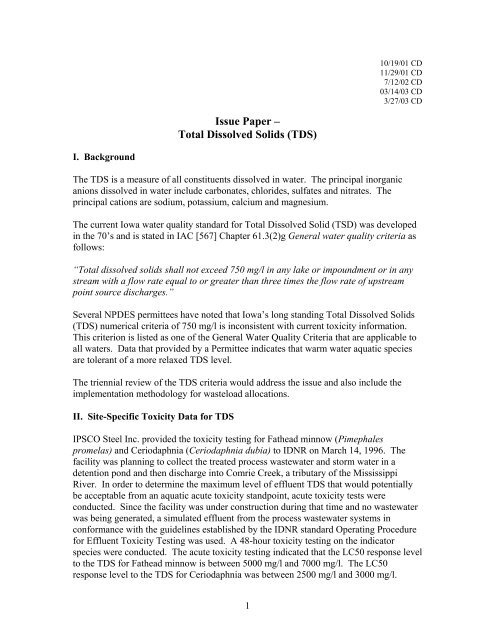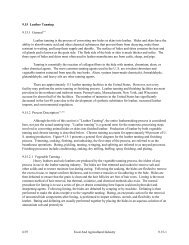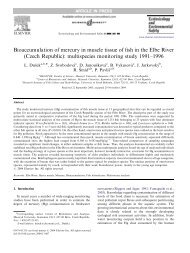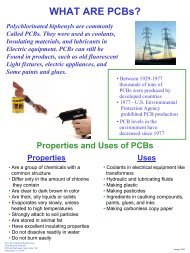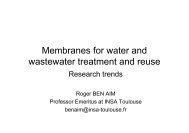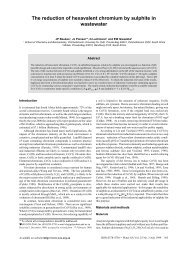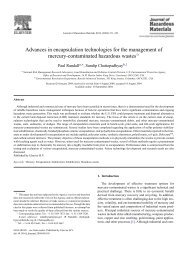Issue Paper – Total Dissolved Solids (TDS)
Issue Paper – Total Dissolved Solids (TDS)
Issue Paper – Total Dissolved Solids (TDS)
You also want an ePaper? Increase the reach of your titles
YUMPU automatically turns print PDFs into web optimized ePapers that Google loves.
10/19/01 CD11/29/01 CD7/12/02 CD03/14/03 CD3/27/03 CD<strong>Issue</strong> <strong>Paper</strong> <strong>–</strong><strong>Total</strong> <strong>Dissolved</strong> <strong>Solids</strong> (<strong>TDS</strong>)I. BackgroundThe <strong>TDS</strong> is a measure of all constituents dissolved in water. The principal inorganicanions dissolved in water include carbonates, chlorides, sulfates and nitrates. Theprincipal cations are sodium, potassium, calcium and magnesium.The current Iowa water quality standard for <strong>Total</strong> <strong>Dissolved</strong> Solid (TSD) was developedin the 70’s and is stated in IAC [567] Chapter 61.3(2)g General water quality criteria asfollows:“<strong>Total</strong> dissolved solids shall not exceed 750 mg/l in any lake or impoundment or in anystream with a flow rate equal to or greater than three times the flow rate of upstreampoint source discharges.”Several NPDES permittees have noted that Iowa’s long standing <strong>Total</strong> <strong>Dissolved</strong> <strong>Solids</strong>(<strong>TDS</strong>) numerical criteria of 750 mg/l is inconsistent with current toxicity information.This criterion is listed as one of the General Water Quality Criteria that are applicable toall waters. Data that provided by a Permittee indicates that warm water aquatic speciesare tolerant of a more relaxed <strong>TDS</strong> level.The triennial review of the <strong>TDS</strong> criteria would address the issue and also include theimplementation methodology for wasteload allocations.II. Site-Specific Toxicity Data for <strong>TDS</strong>IPSCO Steel Inc. provided the toxicity testing for Fathead minnow (Pimephalespromelas) and Ceriodaphnia (Ceriodaphnia dubia) to IDNR on March 14, 1996. Thefacility was planning to collect the treated process wastewater and storm water in adetention pond and then discharge into Comrie Creek, a tributary of the MississippiRiver. In order to determine the maximum level of effluent <strong>TDS</strong> that would potentiallybe acceptable from an aquatic acute toxicity standpoint, acute toxicity tests wereconducted. Since the facility was under construction during that time and no wastewaterwas being generated, a simulated effluent from the process wastewater systems inconformance with the guidelines established by the IDNR standard Operating Procedurefor Effluent Toxicity Testing was used. A 48-hour toxicity testing on the indicatorspecies were conducted. The acute toxicity testing indicated that the LC50 response levelto the <strong>TDS</strong> for Fathead minnow is between 5000 mg/l and 7000 mg/l. The LC50response level to the <strong>TDS</strong> for Ceriodaphnia was between 2500 mg/l and 3000 mg/l.1
III. <strong>TDS</strong> Information from Different SourcesAll species of fish and other aquatic life must tolerate a range of dissolved solidsconcentrations in order to survive under natural conditions. According to the redbook ofEPA (Quality Criteria for Water, 1976), studies have shown that lakes with dissolvedsolids in excess of 15,000 mg/l were unsuitable for most freshwater fishes.It has also been reported that for livestock, 3000 mg/l of <strong>TDS</strong> should be satisfactory foranimal consumption under most circumstances.The report that IPSCO Steel Inc. submitted to IDNR included some <strong>TDS</strong> testinginformation on different freshwater fishes and other organisms. Table 1 presents theinformation on certain species that also present in Iowa streams.Table 1. Toxicity Test Data on Certain Species based on LiteratureOrganisms Concentration (mg/L) Reported EffectDaphnia magna 9,500-11,500 96-hr LC50Hyalella azteca 11,500 96-hr LC50Bigmouth buffalo9,000 Upper tolerance limitEmerging fryBlack buffalo9,000 Upper tolerance limitEmerging fryChannel catfish 14,000 Upper tolerance limitBlack bullhead 8,00010,000Median toxicity threshold inNaClProbable lethal limitYellow perch 11,500 No adverse effectsFathead minnow 6,000-7,000Acutely lethal5,300-5,900Green Sunfish 10,70020,00096-hr LC50Median toxicity threshold inNaClLethalBluegill 11,900 Lethal limitGolden Shiner 5,600 Upper tolerance limitCommon Carp 12,00018,500-19,000No observed effectUpper tolerance limitBeef cattle 10,000 Safe upper limitDairy cattle 7,150 Safe upper limitPoultry 2,860 Safe upper limitIV. <strong>TDS</strong> Criteria in Other States1. Kansas2
(1) Domestic Water Supply:Chloride <strong>–</strong> 250 mg/lSulfate <strong>–</strong> 250 mg/l(2) Aquatic Life Use:Chloride <strong>–</strong> 860 mg/l (Acute)(3) Agricultural Livestock Use:Sulfate <strong>–</strong> 1000 mg/l2. Missouri(1) Drinking Water Use:Chloride <strong>–</strong> 250 mg/lSulfate <strong>–</strong> 250 mg/l(2) Protection of Aquatic Life:Chloride <strong>–</strong> 860 mg/l (Acute), 230 mg/l (Chronic)3. Nebraska(1) Drinking Water UseChloride: 250 mg/lSulfate: 250 mg/l<strong>TDS</strong>: 500 mg/l(2) Agricultural UseConductivity: 2,000 µmho/cm between April 1 and September 30 (equivalent to <strong>TDS</strong> of1280 <strong>–</strong> 1400 mg/l).NO3 and NO2 as Nitrogen: not to exceed 100 mg/lSelenium: not to exceed 0.02 mg/l3. Illinois(1) General Water Quality Standards:Chloride <strong>–</strong> 500 mg/lSulfate <strong>–</strong> 500 mg/l<strong>TDS</strong> <strong>–</strong> 1000 mg/l3
(2) Public and Food Processing Water Supply StandardsChloride <strong>–</strong> 250 mg/lSulfate <strong>–</strong> 250 mg/l<strong>TDS</strong> <strong>–</strong> 500 mg/l(3) Secondary Contact and Indigenous Aquatic Life Standards:<strong>TDS</strong> <strong>–</strong> 1500 mg/l.4. State of PennsylvaniaFor Public Water Supply use, the <strong>TDS</strong>, chloride and sulfate water quality standards are:Parameters Monthly Average Daily Maximum<strong>TDS</strong> 500 750Chloride - 250Sulfate - 250These standards only apply to public water supply uses.Most States have a <strong>TDS</strong> criterion of 500 mg/l for domestic drinking water supply, andchloride and sulfate range from 200 to 250 mg/l for domestic water supply. For aquaticlife, the values range from 250 mg/l to 2500 mg/l. Some states limit the <strong>TDS</strong>concentration not exceeding 133% of ambient stream concentration. Some States do nothave any specific numeric criteria for <strong>TDS</strong>.V. Discussion of <strong>TDS</strong> as a Water Quality ParameterSome studies (Mount et al., 1997) indicated that aquatic organisms respond differently todifferent <strong>TDS</strong> compositions. Mount et al. (1997) also demonstrated that relative iontoxicity was in the order of K + > HCO 3 - ≈ Mg 2+ > Cl - >SO 4 2- . EPA’s chloride criteriadocument (1988) indicated that when compared on the basis of chloride, the chlorides ofpotassium, calcium, and magnesium are generally more acutely toxic to aquatic animalsthan sodium chloride. Thus, the toxicity of <strong>TDS</strong> may vary depending on the specificconstituent compositions of the <strong>TDS</strong> in the effluent. The same problems would relate tothe effects of <strong>TDS</strong> on livestock. However, there is still a lack of sufficient research datarequired to quantify the potential effects of all the different constituents of <strong>TDS</strong>.VI. Agricultural Uses: <strong>TDS</strong> and Individual IonsA. Livestock Watering4
Both the US and Canada have developed “Guides to the Use of Saline Waters forLivestock Watering.” The Canadian Task Force on Water Quality (1987) published botha Summary <strong>–</strong> Guidelines for Livestock Drinking Water Quality and a Guide to Use ofSaline Water for Livestock Watering. They are listed as follows:Table 2. Summary <strong>–</strong> Guidelines for LivestockDrinking Water QualityParameterGuidelines (mg/l)Major Ions and NutrientsCalcium 1000Nitrate plus nitrite 100Nitrite alone 10Sulfate 1000<strong>TDS</strong> 3000The National Academy of Sciences (1974) published a Guide to the Use of Saline Watersfor Livestock and Poultry. It states that “if the <strong>TDS</strong> is between 1000 <strong>–</strong> 2999 mg/l, thewaters should be satisfactory for all classes of livestock and poultry. They may causetemporary and mild diarrhea in livestock not accustomed to them or watery droppings inpoultry, but should not affect their health or performance.”The web site of “Manitoba Agriculture and Food” pointed out an upper limit of 300 <strong>–</strong>400 mg/l of magnesium has been suggested for dairy cows. For sodium, water with over800 mg sodium/l can cause diarrhea and a drop in milk production in dairy cows.The EPA’s “Quality Criteria for Water” (1976) stated that chickens, swine, cattle, andsheep can survive on saline waters up to 15,000 mg/l salts of sodium and calciumcombined with bicarbonates, chlorides, and sulfates but only 10,000 mg/l ofcorresponding salts of potassium and magnesium. The approximate limit for highlyalkaline waters containing sodium and calcium carbonates is 5,000 mg/l.Rodenburg (1989) indicated that routine water analysis for livestock use should include<strong>TDS</strong>, sodium, magnesium, calcium, sulfate, nitrate, iron and pH. Rodenburg (1989) alsopointed out that studies demonstrate that magnesium, sodium, and sulfate are toxic atlower levels than calcium, chloride or bicarbonate, and that there will be highly variableresponse to water of 1000 to 5000 mg/l <strong>TDS</strong>, depending on which ions dominate. Heprovided the water quality criteria for dairy cattle. The following table lists the major ioncriteria for dairy cattle based on Rodenburg (1989).5
Table 3. Water Quality Criteria for Dairy CattleIonsMax. Recommended Concentration (mg/l)Sulfate 1000Magnesium 800Sodium 800Calcium (dry cows & growing bulls) 1000Calcium (milking cows & heifers) 2000Nitrate-N 100Most of the studies on <strong>TDS</strong> are based on sodium chloride constituent. Different studiesrecommended different safe values of sodium chloride for livestock uses. The NationalAcademy of Sciences (1974) reported the safe sodium chloride value for cattle as 10,000mg/l. And Jaster et al (1978) reported that the safe sodium chloride value for dairy cowswere 2500 <strong>–</strong> 3500 mg/l. Some studies indicated that for poultry the safe sodium chloridevalue was 3000 mg/l.To summarize the status of the current studies of <strong>TDS</strong> toxicity on aquatic life andlivestock, it is recognized that the toxicity of <strong>TDS</strong> may vary depending on the specificconstituent compositions of the <strong>TDS</strong> in the effluent. However, there are a lot ofuncertainties about the potential effects of all the different constituents of <strong>TDS</strong>. Based onlimited studies on <strong>TDS</strong> and the individual ions, the following water quality criteriashould meet the livestock uses.Table 4. Recommended Water Quality Criteria for Livestock UsesIonsCalcium 1000Magnesium 800Sodium 800Sulfate 1000Nitrate+Nitrite-N 100B. Irrigation Water UsesRecommended Criteria for Livestock Uses(mg/l)Peterson (1999) pointed out that <strong>TDS</strong> levels below 700 mg/l are considered safe; <strong>TDS</strong>between 700 mg/l and 1,750 mg/l are considered possibly safe, while levels above theselevels are considered hazardous to any crop. Peterson (1999) also listed the tolerance ofselected crops to <strong>TDS</strong> in irrigation water, for example, corn as slightly tolerant (<strong>TDS</strong>
Irrigation water containing large amounts of sodium is of special concern due to sodium’seffects on the soil structure. Crops grown on soil having an imbalance of calcium andmagnesium may also exhibit toxic symptoms. Sulfate salts affect sensitive crops bylimiting the uptake of calcium and increasing the adsorption of sodium and potassium,resulting in a disturbance in the cationic balance within the plant. The bicarbonate ion insoil solution harms the mineral nutrition of the plant through its effects on the uptake andmetabolism of nutrients. High concentrations of potassium may introduce a magnesiumdeficiency and iron chlorosis. An imbalance of magnesium may be toxic, but the effectsof both can be reduced by high calcium levels. The Surface Water Quality Objectivespublished by Saskatchewan Environment and Resource Management in August 1997listed corn as one of the moderately tolerant plant to sodium and chloride. The toleranceconcentration to chloride and sodium in irrigation water for corns are Chloride (335 <strong>–</strong>710mg/l) and Sodium (230 <strong>–</strong> 460mg/l). Also, Mills (2001) provided the followingtoxicity values for chloride, iron and NO3 to plants.Table 5. Toxicity Data for Chloride, Iron and NO3 in Irrigation waterChloride Ion Conc. Suitability for Irrigation< 350 mg/l Suitable all crops350 <strong>–</strong> 700 mg/l Suitable for high,medium and low salttolerant crops700 <strong>–</strong> 900 mg/l Suitable for high andmedium salt tolerancecrops900 <strong>–</strong> 1300 mg/l Suitable for high salttolerant crops only.Greater than 1300 mg/l Too saline for irrigationof any cropsIron< 1 mg/lNO3
However, at the Technical Advisory Committee meeting on March 21, 2003, thecommittee members agreed to drop the chloride value of 900 mg/l for irrigation usesat this time because of lack of sufficient information. The IDNR and the committeecould visit the issue later when new information becomes available.VI. Proposed Ion Criteria for IowaBased on the literature review and the recommendations by WQS Technical AdvisoryCommittee, the Department proposes the following ion criteria and approach for theprotection of both the agricultural use and the aquatic life use.1. Protection of Agricultural Uses(1) Ion Criteria ValuesTable 7. Recommended Water Quality Criteria for Agricultural UsesIonsCalcium 1000Magnesium 800Sodium 800Sulfate 1000Nitrate+Nitrite-N 100Recommended Criteria for Livestock Uses(mg/l)On March 21, 2003, the TAC members agreed that the above ion criteria values shouldbe included in the Support Document for implementation since these numbers are basedon guidelines for livestock uses not criteria-based toxicity tests.(2) ImplementationThe ion criteria values shown in Table 7 should be applied at the end-of-pipe in generaluse waters, and at the end of the mixing zone in designated waters.2. Protection of Aquatic Life UsesThe Technical Advisory Committee on the March 21 th meeting agreed that in order toprotect the aquatic life uses, Whole Effluent Toxicity (WET) test of <strong>TDS</strong> is requiredwhenever the facility requests for a permit renewal every five years. The facility alsoneeds to measure the ion constituents in the effluent at the same time. The followingtable lists the parameters need to be included in the specific ion constituent test.8
Table 8. Ion Constituents Tested in the WET TestIons<strong>TDS</strong>CalciumPotassiumMagnesiumSodiumSulfateIonNitrate+Nitrite-NIf the effluent discharges into a general use stream, 100% of the effluent should be usedin the WET test. If the effluent discharges directly into a designated stream, a 2.5% ofthe stream 7Q10 flow is allowed for dilution in the WET test. The WET test shouldfollow the EPA published manual of “Methods for Measuring the Acute Toxicity ofEffluents and Receiving Waters to Freshwater and Marine Organisms” adopted as finalrule on November 19, 2002. And the WET test should be performed for two freshwaterorganisms: fathead minnows and Ceriodaphnia dubia.In conclusion, all Waters of the State should meet the above requirements to protect boththe agricultural and aquatic life uses.VIII. Proposed Rule Changes: reserved for future.9
ReferencesBirge, W. J., J.A. Black, A.G. Westerman, T.M. Short, S.B. Taylor, D.M. Bruser, andE.D. Wallingford. 1985. Recommendations on numerical values for regulating iron andchloride concentrations for the purpose of protecting warmwater species of aquatic life inthe commonwealth of Kentucky. University of Kentucky, Lexington, K.Y.Jaster, E.H., J.D. Schuh, and T.N. Wegner. 1978. Physiological Effects of SalineDrinking Water on High Producing Dairy Cows. Journal of Dairy Science. Vol. 61:66.Mills, B. Interpreting Water Analysis for Crop and Pasture. March 2001. FarmingSystems Institute, Toowoomba.Mount, David R., et al. 1997. Statistical models to predict the toxicity of major ions toCeriodaphnia Dubia, Daphnia Magna and Pimephales Promelas (Fathead Minnows).Environmental Toxicology and Chemistry. Vol. 16:10, pp. 2009-2019.Peterson, H.G. Irrigation and Salinity. 1999. WateResearch Corp. and Agriculture andAgri-Food Canada-Prairie Farm Rehabilitation Administration.Rodenburg, J. Practical Water Evaluation for Dairy Cattle. Ontario Ministry ofAgriculture & Food, Woodstock, Ontario, Canada.The Task Force on Water Quality Guidelines of the Canadian Council of Resource andEnvironmental Ministers. March 1987. Canadian water quality guidelines.U.S. EPA. Quality Criteria for Water. July 1976. Office of Water and HazardousMaterials, Washington, D.C. 20460.U.S. EPA. 1988. Ambient water quality criteria for Chloride. Office of WaterRegulations and Standards, Washington, D.C. 20460.10
Appendix A: Ion Concentration Comparison(surface water vs. groundwater vs. industrial discharge)Table A1. Surface and Groundwater Ion ConcentrationsGroundwater(70 stations-2000water year)Des Moines R.at Des MoinesMissouri R. @OmahaMississippiRiver@ ClintonWAPSIPINICONRiver@ TRIPOLIIOWARiver@Ro<strong>TDS</strong> 555 422 522.9 230.6 249 411.8Hardness as 356 270 163. -- --CaCo3Ca 89 77.2 66.3 38.9 51.0 83.6Mg 29 27.8 25.4 15.7 11.7 26.5K 4 2.8 7.0 2.61 2.0 2.6Na 32 17.8 55.7 9.15 9.7 9.5CO3 as -- -- 1.0 1.00 0 0.6CaCo3HCO3 as -- -- 199.3 170. 155 282CaCo3Chloride 22 33.2 14.8 13.98 21.4 19.9Sulfate 106 77.5 197.6 25.92 21.5 42.3NO3 5 7.5 1.5 1.80 5.3 7.1The following shows a few sample industrial discharge characteristics:Table A2. ADM <strong>–</strong> Des Moines Discharge CharacteristicsEffluentDes Moines RiverParameter Month Concentration (mg/l) Concentration (mg/l)<strong>TDS</strong> 9/02 443 4008/02 544 3807/02 645 3806/02 593 4005/02 322 3904/02 418 4803/02 705 4702/02 716 5401/02 640 55012/01 464 38011/01 420 34010/01 334 350Table A3. Siouxland Ethanol Facility, Sioux Center, Sioux County, IAParameters RawGroundwaterRO RejectWaterSurface Water(Tributary)<strong>TDS</strong> 2113 7288 703 (Big Siouxdata)Ca 305 1033 129Mg 138 458 58K 0 0 1.5Na 148 485 2011
Cl 23 131 35SO4 1420 4716 107NO3 10 30 128HCO3 155 412 NATable A4. Midwest Grain Processorsin Kossuth CountyParameters GroundwaterSource(mg/l)TowerBlowdownEffluent<strong>TDS</strong> 878 3020Ca 136Mg 194K 0Na 222Iron 0.588Cl 14.6SO4 1510Table A5. Little Sioux Ethanol:Simulated BlowdownParameters Tower BlowdownEffluent<strong>TDS</strong> 3240 as CaCO3Ca 637.5Mg 184.8K 32.5Na 297Iron 1.3Cl 26.9SO4 226512


